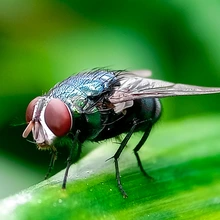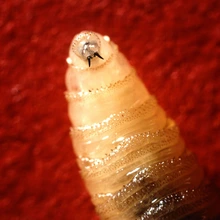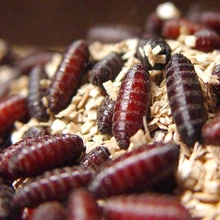- Location: NWS is endemic in Cuba, Haiti, the Dominican Republic and countries in South America, with cases spreading north to Costa Rica, Nicaragua, Honduras, Guatemala, Belize, El Salvador and Mexico.
- Name: New World Screwworm (NWS, Cochliomyia hominivorax)
- Type: Pest
- Affected Species: livestock (small and large), horses, dogs, cats, wildlife, birds, and humans
The USDA posts updates about the spread of New World screwworm along with information on what to look for and how to prevent it.
Transmission
New World Screwworm (NWS) flies can be devastating to livestock and other mammals because of the growth cycle of their larvae. Screwworm fly larvae, or maggots, burrow into the flesh of living animals causing serious, and even deadly, damage to the animal. Adult screwworm flies are about the size of a common housefly (or slightly larger) with orange eyes, a metallic blue or green body, and three dark stripes along their backs.
Clinical signs
Maggots in wounds or other body openings (like nose, ears, umbilicus, or genitalia) of any warm-blooded animal (including birds and humans). These flies are attracted to wounds as small as a tick bite but thrive on open wounds or surgical sites. The egg masses may be around or in the wound; larvae may be visible by the third day of infestation, and because they burrow into and feed on live flesh, NWS maggots are often found deeper in the wounds or openings and the wound site will be enlarged, draining, and have a characteristic decaying smell. Other species of maggots usually appear closer to the surface of the wound. Screwworm infestations are very painful, so animals may become depressed, stop eating, and separate themselves from other animals or people.
Diagnosis
Immediately report any sign of maggots, or infestations in wounds to a local accredited veterinarian, your state animal health official, or a USDA veterinarian. If you are a veterinarian, New World screwworm is a reportable disease, thus, you are legally obligated to report this to the Arizona State Veterinarian.
Treatment
Animals infested with NWS should be treated according to their veterinarian's recommendations. People with a suspected NWS infestation should seek immediate medical treatment following the Centers for Disease Control and Prevention (CDC) guidelines.
Prognosis
Livestock infested with NWS can recover if caught early and treated at the direction of a veterinarian. However, if discovered after the infestation is well established, and/or left untreated the prognosis is poor leading to severe tissue damage, secondary infections, and even death. Left untreated, animals may die within 1 week of being infested.
Eradication
The United States Department of Agriculture (USDA) eradicated NWS from the United States in 1966 by releasing sterile male NWS flies into a known active area. Since female NWS mate just once in their lifecycle, the breeding results in unfertilized eggs, which progressively reduces that NWS population to the point of eradication. However, there is a constant risk of re-introduction into the United States which would result in millions of dollars lost from livestock losses, trade embargoes and eradication work. During the 20th century, the presence of NWS cost the U.S. livestock industry more than $100 million annually.
Prevention

ALIRT New World Screwworm Surveillance Project Collection Kit includes collection instructions, forceps, collection vial, sample bag, and mailing tube.
Debbie Reed, Cooperative Extension
The most effective prevention is prohibiting the reintroduction of New World screwworms to the United States. The Arizona Livestock Incident Response Team (ALIRT) is initiating a Pilot New World Screwworm Surveillance Project which involves distributing NWS larvae collection kits to veterinarians, ranchers, Arizona Department of Agriculture and University of Arizona Cooperative Extension personnel, to assist in submitting suspect maggot larvae to the Arizona Veterinary Diagnostic Laboratory for early identification. Positively identified screwworm larvae will be reported to the federal agriculture authorities. Anyone may report suspected cases of screwworm, and we need everyone to be on the lookout. This disease is serious and can have catastrophic impacts on US agriculture, and animal and public health. Catching it early and eliminating it quickly is vital.
Steps you can take to avoid infestation: 1) Be alert for NWS symptoms in pets and livestock. 2) Quarantine any suspect animals, and work with your veterinarian to send larvae samples and treat the animals. 3) Ensure that pets or livestock traveling internationally are inspected for screwworm. 4) Check your vehicle for screwworm flies if you are in an NWS-infested area.
In areas where NWS is found, measures should be implemented 1) To the extent possible, eliminate or delay performing wounding procedures such as dehorning, branding, shearing, ear notching, tail docking and castration. 2) Since untreated umbilical cords of newborn animals and foot lesions are commonly infested sites, immediately treat all wounds with approved insecticides; it may also be prudent to follow up with precautionary spraying of animals with insecticide before transport.
The Arizona Livestock Incident Response Team (ALIRT) website has information on the New World screwworm surveillance project.
* The ALIRT New World Screwworm Surveillance Project Collection Kit was adapted from a NWS collection kit and surveillance project developed by the New Mexico Department of Agriculture – Office of the State Veterinarian headed by Samantha Holeck, DVM -NM State Veterinarian.
Resources
- Centers for Disease Control (CDC) New World screwworm information page
- New World screwworm fact sheet from Beef Quality Assurance
- Pesticides for Control of New World Screwworm from the USDA APHIS









